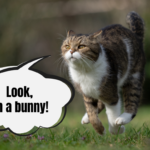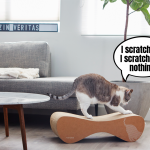It’s no secret that most cats don’t like to bathe or sit in the bathtub for long periods of time, but water plays an extremely important role in their lives. Naturally, wild cats drink little and take the water they need to live with their food. Unfortunately, it’s no longer that easy to take care of this diet and the health of your cat. As cats are reluctant to drink water, there is a big task for the Carers. How to encourage your cat to drink water?
The importance of water in your cat’s diet
Water is one of the most important components of a cat’s diet. A cat’s body – like that of a human being – consists of about 2/3 water. Water is not only the building block of the body, but is also responsible for the proper course of such processes as: transport of oxygen and nutrients, thermoregulation, disposal of by-products. A water shortage can have serious consequences for your cat’s health. Insufficient water intake can lead to dehydration which reduces your cat’s immunity and health, increasing her vulnerability to various types of diseases. It can also lead to thicker bladder urine, which promotes the precipitation of crystals and the risk of lower urinary tract disease. Water deficiency may also lead to disorders of internal organs and kidney diseases.
Symptoms of dehydration in a cat
Dehydration in a cat is very difficult to see quickly. It usually only appears when the water level in the body is too low. Most often it is:
dry mouth mucous membrane, saliva viscosity,
● the nozzle,
● lowering skin elasticity,
a slight tachycardia,
● skin folds that don’t go back to their original position, the fur is more awkward,
● heart palpitations,
● sunken eyelids,
● circulatory shock.
Why don’t cats drink enough?
There is no clear answer to this question. There are many reasons why cats avoid drinking water. It is assumed that their wildness and the living conditions in which they actually live are at the root. Wild cats take water with their food. That’s why it’s important to feed your cat a diet and wet food from which she naturally draws water, as is the case in nature. In addition, each cat has a different need for this nutrient.
Many observations have shown that cats prefer ‘live’, non-standing water. It is believed that they should have more than one place to drink fresh water at home. This is ideal for cats – two large water michauses set up at two different points in the cat’s communication route. Ideally, the water bowls should be located at a favourite fur watch point, e.g. on a windowsill or countertop, or where cats most often move from one room to another. For demanding pets it’s worth to buy a drinker in the form of a fountain – from our experience we advise to choose one that works quietly;) There are also cats that love to absorb water from the tap – we don’t recommend unscrewing it all the time – after all, we should save this valuable component of our Mother Earth – but during our stay in the bathroom, it’s worth to give your cat access to the flowing water straight from the tap. Our boys – seeing that we are in the bathroom – jumped on the edge of the bathtub by themselves and demanded that the tap be turned off:)
It should be remembered that the water for the cat should be fresh and sufficient to cover the needs of the cat. Also important is the bowl itself and what it is made of. Unfortunately, but often used plastic bowls aren’t the right choice (it also depends on what kind of plastic it is) because they easily scratch (if the plastic is of poor quality) they lead to water contamination by bacteria living in the corners of these scratches. Cheap plastic retains its smell and this can discourage cats from drinking water. Lightweight plastic bowls, on the other hand, “travel” around the whole apartment, which may also not appeal to our purringers. You can take care of your cat’s health by buying glass, porcelain or stainless steel bowls. Moreover, the dish should be wide enough and comfortable for the cat – remember about cats vibrating! Fur cats don’t like to get them wet in food or water. Also, regular cleaning of water bowls and daily water changes will help to maintain proper hygiene when taking care of our little ones.
Also remember not to place water dishes next to food bowls. Cats don’t like it because their instincts tell them the water may have been contaminated with food debris and bacteria. In nature, wild cats never drink water where they have hunted their prey. Remember that the instincts in our fluffy, sweet, homemade furs are still alive and let’s not be fooled by their couch-like behaviour. Our children are still wild animals, but in this “Garfield” edition:)
How do I encourage my cat to drink water?
Your cat’s health is paramount, so before you start encouraging her to drink water, make sure she has the right conditions for taking fluids. It’s a good idea to start by checking the bowl to see if it’s the right size and the right place in the house. Fresh water, changed regularly, is essential. Other ways to encourage your cat to drink water are:
Dilute a wet food and make a so-called cat’s soup,
● boiling a cat’s broth to drink,
● throwing an ice cube into a bowl,
● filling a bowl of water all the way up to the edges,
● buying a cat fountain to replace drinking water from a leaking tap,
●. daily water change to fresh water,
● diversifying the height and width by purchasing new bowls,
Try spring water or filtered water – any water that’s not mineral, because the minerals in the water can affect your cat’s electrolyte balance.
How do I measure my cat’s optimal water intake?
According to the Veterinary Nutrition Manual, calculating the amount of water your cat needs is by multiplying the number of grams of the recommended dry food x 2.5. If your cat is fed both a dry and a wet food, you can take into account that the food has ¾ of its composition of water, which reduces her need for water.
How much water your cat should drink depends on a number of factors including season, physical activity, food intake (dry or wet) and disease. The above advice applies to healthy furs and moderately active furs.
To sum up,
Make sure your cat’s water and food bowls are the right size for her and that she gets as much as she should during the day. Most cats will drink properly if they have a chance to do so: constant access to clean, fresh water, in clean dishes placed in safe places for them, away from the food bowls. To ensure your cat’s health, watch her drink and make changes to suit her needs. Think carefully about what you’re feeding your cat – we recommend that you feed your cat a wet food that provides plenty of water itself, or at least a combination of dry and wet meals for the day. Feeding your cat only dry food can cause water shortages and illness.
Key issues related to drinking water:
- Choosing the right water bowl for your cat,
- Choosing the right place for the water bowl,
- Fresh water,
- Water movement,
- Fur diet.
If you are dealing with special cases of extremely reluctant representatives of the cat’s breed, it may be worth resorting to trickery. We’re talking about learning through play. Many manufacturers offer cat toys in the form of fountains or waterfalls. This form of access to water is beneficial for another reason. In many cases, a cat doesn’t want to drink water, because it is standing for several hours and not fresh water. And a fountain or waterfall ensures your cat has constant access to aerated running water and is also very entertaining and fun.
fabCats how is your home? Do your cats drink enough water? What water do they prefer and what do they prefer to drink from? Let as know in the comments





